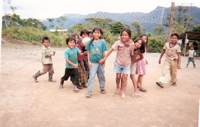
|
Drawings in Argentina
Return to home |
Children's drawingA child's perceptions, and especially his or her feelings about his or her body, have an impact on his or her overall self-concept. This is explored in a special way through the drawings children make. When studying body image through drawing completion, it was found that half of five-year-olds can already adequately add hair, facial features, neck, limbs, and even fingers, but they do not achieve facial expression until they are eight or nine years old.
Ilg and Ames reported that "at approximately five years of age, about 80% of children (...) were able to draw their eyes when touched by the examiner, and, under similar conditions, about 50% were able to make a drawing of their eyebrows" (Cratty, 1982). The same authors confirmed that the earliest finger drawn was the thumb (90% at five years of age). Since body image is the result of a multitude of conscious and unconscious kinesthetic sensations, perceptions of movement, and the influence of social interactions, its formation and modification is a process of slow evolution, which can be recorded through drawing. Drawing in adolescenceThe rapid bodily growth of puberty, which exceeds the capacity to adapt one's self-image to the new reality. This will lead to a temporary inadequacy of movement patterns during early adolescence: the main cause of the typical "clumsiness" of this stage.
To enter this youthful world, we will be forced to use games and often audiovisual media that sometimes have a technological appeal that goes beyond the playful nature of simple drawing. Here we will see an example of children's drawings from different parts of South America. Analysis of drawings in children up to 12 years old from groups in Argentina, Ecuador and BrazilAuthor: Federico Beines The free-drawing technique is proposed as a method for individual case research in child psychiatry, as well as for comparative cross-cultural research. This paper summarizes the experience of six field projects conducted between 2000 and 2005 in three South American countries. The drawings of children up to 12 years of age, both male and female, and those in school or not, were evaluated. A total of 40 participants completed their drawings during their first contact with the experimenter, either upon arrival in a village or on the day the children were admitted to a hospital.
As we had anticipated in a study on drawings carried out in Argentina (1), we found it necessary to expand the sample to other cultures in order to validate the hypotheses. On that occasion, a drawing experiment was carried out by observing a mirror, and it was found that children aged 5 and 6 already had a clear influence of their schooling as well as certain cultural traits - compared to a sample of younger children. This helps us to reformulate Piaget's idea about the cultural invariants that occur in children of all cultures, intended until the approximate age of eight. Previous experiences with drawingsIn the Argentine scientific literature, we do not find many references to children's drawings according to their cultural context—at least from a psychological perspective. We can point to the contribution of those who worked on the regional standardization of a series of tests such as the visuomotor test (2), as well as the standardization of human figure drawing at CONICET (3,4). We also find a qualitative study of the drawings of street children in Buenos Aires (5). In any case, the first work that appears when looking for experimental background in drawing is that of Telma Reca (6) who carried out a study on children between 12 and 15 years old from the provinces of San Juan, La Rioja and Buenos Aires. In this case the object of analysis was the human figure in five cultural groups: "Rural populations, intermediate city, metropolis-working class, metropolis-middle class, metropolis-upper class". In that work the personality of the subject is analyzed from techniques "that are highly influenced by specific training and other cultural factors." This specific training is the axis of Reca's work (turning the social into environmental influence) as well as of those who carried out the regional standardization of the tests.
This paper focuses on those "other cultural factors" that have escaped study.
by Telma Reca, for whom culture is synonymous with information (from a quantitative perspective, for example, the greater the subject's vocabulary, the greater their "culture"). In this way, we will approach culture more closely from what functions as the uniqueness of a given group and not as an attempt to equalize productions according to social stratum. Culture will then be defined by the trait that diverges from what is expected by the transcultural, transforming it—since we start from the hypothesis that there is no pure transcultural or "universal" trait. GoalsTo compare drawings from different groups cross-culturally, in order to extract similarities and differences related to the following axes: the role of clarification and cultural influences in the choice and form of the drawn motifs. The validity of the freehand drawing technique for the analysis of anthropological data will be discussed, while cultural variables that are not usually considered in individual clinical studies will be highlighted.
|

